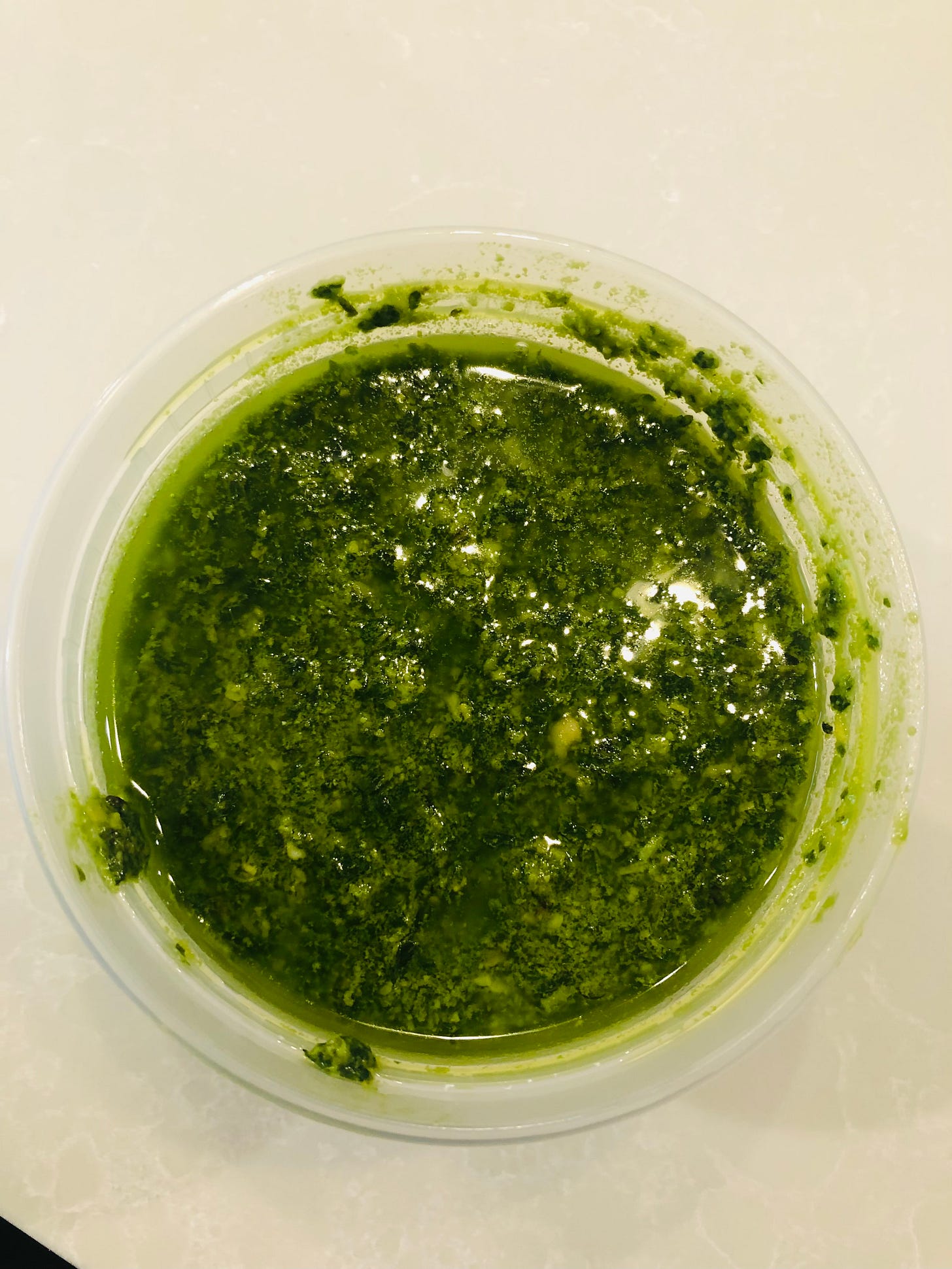Vinaigrette
Learning the hows and whys of emulsification makes for a powerful lever in the kitchen
Stop buying salad dressing.
I bet if you pulled every jar of store-bought salad dressing from your fridge right now and read the ingredients, some kind of sugar or corn syrup is second or third one on the list. It’s overprocessed crap that’s pretty much only useful poured over a bed of salad greens.
But a true vinaigrette is more than just salad dressing. Think of it more like a sauce that can be used to enhance not only salads, but cooked vegetable dishes, meat, fish, and more.
Chimichurri is a vinaigrette. Pesto is a vinaigrette. Any herbed dressing is a vinaigrette. (I particularly like pouring an herbed vinaigrette over pan-seared fish with mashed potatoes.) It’s a quick, simple sauce that levels up anything you make.
Of course first, you need to know how to make it.
Most first-time vinaigrettes are thin, runny messes. That’s because by definition, a vinaigrette is a combination of fat and acid… literally oil and vinegar, two things that naturally don’t mix. The trick to doing it right is learning to create a proper emulsification.
An emulsification is the process of mixing two liquids that don’t dissolve into each other. You’re dispersing one liquid into another, through force. That takes either a bit of whisking effort, or getting a blender/processor dirty, in order to break up the droplets of the liquid small enough to allow them to combine.
Here’s something I read that helped me understand this process better:
The two liquids in an emulsion can be thought of as the container and the contained: one liquid is broken up into separate droplets, and these droplets are contained in and surrounded by the intact mass of the other liquid.
On Food & Cooking, McGee
In other words, one liquid is the container, and the other liquid is the one being contained.
Usually, the container is the acid, and the oil is the contained. The tricky part about this is the ratio, typical one part acid to three parts fat… meaning that the liquid with the smaller volume (the vinegar) is asked to contain a liquid three times its volume (the oil).
That’s why you start with the container (vinegar) first, and slowly drip in the oil. In this early stage, the vinegar container is larger in volume than the oil you’re trying to contain in it. As you slowly add the oil, the oil and vinegar begin to combine, gradually increasing the size of the container to then accept more oil.
Once the size of the container is larger than the amount of oil you have left to add, you can pour the oil more quickly. But if you just impatiently pour in the oil from the start and hope your vigorous whisking will make up for it (like I pretty much did for years), you’ll likely wind up with a good workout but a shitty sauce. The vinegar just can’t contain all that oil.
A few notes:
Mustard: Adding a thickening agent to the vinegar before pouring in the oil helps. In most cases, this is a dollop of dijon mustard. Whisking the vinegar with a little mustard thickens the vinegar container, making it more viscous, which creates more “drag” on the oil droplets being whisked in.
Time: A vinaigrette is really just a temporary emulsion. Given enough time, it will eventually separate and the oil and vinegar will revert back to their separate states. Which brings me to…
Chemistry: A true emulsification is a chemical reaction, bonding molecules permanently. Emulsifications like mayonnaise use an egg yolk, which when whisked with oil in the same manner creates a more permanent bond that does not separate over time. The dijon in the vinaigrette is not an emulsifier, but rather a thickener. The amount of mustard you’d need to create a permanent emulsion would be so great that it would overpower the vinaigrette and just be another mustard sauce.
Too much heat will cause a vinaigrette to “break” — meaning revert back to its individual parts. So be careful when making a warm vinaigrette.
Basic Method
Put a tablespoon of vinegar into a bowl with a dollop of dijon mustard and salt. Whisk until combined and thick
Vigorously whisk while slowly pouring in three tablespoons of oil until thick.
Fancy Method
Muddled fine-diced shallots into the vinegar with salt and let sit a few minutes to let the acid mellow the bite of the shallots (this is technically a quick pickle).
Add dijon, and some finely chopped herbs, and even a little honey if you like
Whisk until creamy. Then add/whisk the oil
More Notes:
Red vinegar is pretty standard, but champagne vinegar is a level up
Use a neutral oil like sunflower, not olive oil. Or if you really want olive oil, make it just 25% of the total oil added, and do so at the very end.
Add salt to the acid before introducing the oil, as salt dissolves slower in oil.
Once you get the basic vinaigrette down, you make all sorts of variations. Use citrus (like orange juice) as the acid, or blend in tomatoes or other pureed vegetables, or saturate it with chopped herbs (like a chimichurri or pesto), use the fat from a pan seared chicken (or bacon!) instead of oil and whisk it all right there in the pan to pour over the chicken your just seared.
One technique/concept, many uses. And it’s the understanding of the “why” behind it that makes it all possible.


